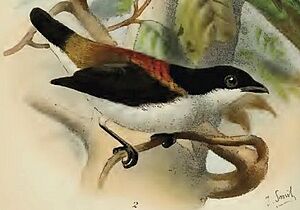Cebu flowerpecker facts for kids
Quick facts for kids Cebu flowerpecker |
|
|---|---|
 |
|
| by Joseph Smit | |
| Conservation status | |
| Scientific classification | |
| Genus: |
Dicaeum
|
| Species: |
quadricolor
|
The Cebu flowerpecker (Dicaeum quadricolor) is a tiny songbird. It lives only on Cebu Island in the Philippines. People thought it was extinct for a long time. But in 1992, it was found again! It was hiding in a small forest area called the Central Cebu Protected Landscape.
Since then, this special bird has been seen in three other places. These include the Nug-as forest in Alcoy, Mount Lantoy in Argao, and forests in Dalaguete. This colorful bird usually grows to be about 11 or 12 centimeters long. That's about the size of your hand!
Contents
What Does It Look Like?
This bird is called "four-colored" because of its bright feathers. It usually grows to be about 11 or 12 centimeters long.
Male Cebu Flowerpecker
The male bird is very striking. It has a big, triangle-shaped patch on its back. This patch is a bright scarlet or reddish-orange color. Its lower back is a yellowish-brown with a hint of green. The rest of its back, neck, head, wings, and tail are a shiny blue-black. Its belly is a pale yellow. The chin, middle of the belly, armpits, and under the tail and wings are white.
Female Cebu Flowerpecker
The female bird looks a bit different. Her top feathers are brown. Her head is a slightly faded olive color. Her back, wing feathers, and outer parts of her secondary feathers are a strong faded olive. Her rump (the area above her tail) is almost entirely olive-yellow. Her underside is white. It has a light gray-olive-yellow tint that gets brighter towards the middle of her chest and belly. The feathers under her wings and the inner parts of her flight feathers are white.
Where Does It Live?
The Cebu flowerpecker lives in a few special forests on Cebu Island in the Philippines. These places include the Tabunan Forest, the Babayungan Forest in Dalaguete, and the Nug-as Forest in Alcoy.
These birds usually live high up in the thick forest canopy. They like to be near plants that have flowers or fruits. You can find them both deep inside the forests and on the edges.
What Does It Eat?
The Cebu flowerpecker eats small fruits and mistletoe plants to get energy. Mistletoe plants are great for many birds on Cebu. They are easy to find and grow fruits and flowers every month.
The Cebu flowerpecker has been seen eating a special kind of mistletoe called Lepeostegeres cebuensis. This mistletoe is unique because its young leaves and stems have orange-brown scales. It is light green and grows tiny, needle-like pink flowers. These flowers are about 4 millimeters long and grow in bunches. They are a wonderful food source for the Cebu flowerpecker.
How Does It Behave?
Most birds that are active during the day start their day very early in the morning. But the Cebu flowerpecker is different. It is known to be picked on by other stronger birds, like the Red-Striped Flowerpecker. So, it chooses to be active between 9 AM and 1 PM. This is after the busiest time of the day. This way, it avoids competing with those more aggressive birds.
When it's looking for food, it flies quickly to its favorite flowering plant. It eats quickly and then flies away right after. The Cebu flowerpecker doesn't call very often. But when it does, its sound is similar to the Pygmy Flowerpecker’s call.
Why Is It in Danger?
The Cebu flowerpecker is currently listed as critically endangered. This means it is at a very high risk of becoming extinct. Many things threaten this bird.
Main Threats
One of the biggest threats is deforestation. This happens when forests are cut down for farming or for people to collect wood. This severely reduces the places where the birds can find food, shelter, and raise their young.
Another serious threat is building new roads. For example, in the Nug-as forest in Alcoy, road development is happening. This breaks up the forest into smaller pieces, which is called habitat fragmentation. When resources are limited, the Cebu flowerpecker has to compete more with other birds. It is at high risk of losing out in these competitions.
Other Threats
Hunting is a smaller threat. There are not many reports of Cebu flowerpeckers being hunted. People who hunt them face immediate penalties. Other smaller threats include new species moving into their habitat, mining, and climate change. Climate change can cause things like floods and strong storms.
How Are We Helping?
The area where the Cebu flowerpecker lives has shrunk to only about 1,000 hectares. People are working hard to protect this bird.
Conservation Efforts
Current efforts include:
- Teaching people about biodiversity conservation.
- Restoring the bird's natural habitat.
- Managing the biodiversity in the area.
- Protecting the land by the Central Cebu Protected Landscape.
- Setting up special "Critical Habitat" areas.
The Tabunan forest is inside the Central Cebu National Park. However, people sometimes illegally use the forest's resources. Conservationists are pushing for more education and awareness programs in Cebu. This is because local villagers often contribute to habitat loss and resource depletion. By teaching them, they hope to help protect the Cebu flowerpecker's home.


